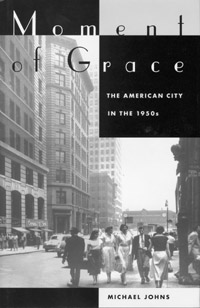Book Review
Moment of Grace: The American City in the 1950s
By Michael Johns. Berkeley: University of California Press, 2003; 148 pp., illustrations, notes, index; cloth $29.95.
 |
This compelling book describes American cities at mid-20th century, when downtowns were packed with throngs of people, neighborhoods offered the full range of commercial and social services, and new suburbs retained strong ties to the city. The author traces the waves of development and demolition that caused tight-knit cities to unravel and inspired the national historic preservation movement in the 1960s. This book also describes the many attractive aspects of urban life that the preservation community attempted to revive in the past four decades.
According to Johns, a professor of geography at the University of California, Berkeley, the American city reached its consummate expression in the 1950s. Downtowns were compact and intimate places that served the cities' economic and cultural needs. Neighborhoods developed around urban manufactories and provided essential shops and services within walking distance. The suburbs relied upon cities for jobs and goods.
As described by Johns, the 1950s also marked a decade when cities began to fragment. Today, downtowns are largely populated by offices, hotels, sports arenas, and entertainment centers as well as by empty lots and abandoned commercial buildings. Older neighborhoods provide housing but are separated from desirable shopping and employment opportunities. The suburbs are largely removed from the fortunes of the central city.
Why did we allow cities to decline in the United States? Johns contends that the post-World War II period was defined by a nearly "blind faith in progress…a forward-looking attitude that lacked nostalgia." American culture was entranced with everything that was new, modern, and efficient. And, "Americans abused nature on a colossal scale in the '50s: drivers tossed garbage from cars, engineers dammed rivers unnecessarily, scientists tested hydrogen bombs above ground, and the factories of the world's mightiest industrial power spewed untreated waste into rivers, lakes, and the air."
Other forces were also at work. People abandoned communal trains, streetcars, and trolleys and took up their individualistic automobiles. The Federal Government offered "heaps of money" for urban renewal and highway construction and subsidized the kind of suburban development that drained the central cities of people and investment. Office towers rose in outlying suburbs and exurbs. Highways became the new infrastructure for the metropolitan area and included major routes that ran through the inner city. Younger families moved away from their ethnic neighborhoods and into new suburban subdivisions that offered a "stronger blend of Americanism."
But Johns does not view the 1950s American city through rose-colored glasses. He addresses the oppressive effects of racial segregation on cities. As cities slipped into a downward spiral, poor neighborhoods became desperate ghettos that filled with rage and exploded during the race riots of the 1960s. Public housing projects that had been shaped by sensitive community planning principles during the 1930s became mass-produced during the 1950s and herded families into superblocks.
Why is this book important to heritage stewardship? First, it describes historical forces that led to passage of environmental legislation, including historic preservation laws and regulations at the Federal, State, and local levels from the 1960s to today. Second, memories of cities of the 1950s have motivated historic preservationists for the past 40 years—since passage of the National Historic Preservation Act of 1966. Preservationists have tried to bring new life to otherwise abandoned central cities and older neighborhoods through incentives and advocacy programs. With these tools, preservationists transformed former industrial warehouses into residential condominiums, surplus school buildings into elderly housing, and abandoned office buildings into hotels. Older neighborhoods were revitalized through return-to-the-city programs, even if the neighborhoods rarely possessed adequate commercial and social services.
The irony is that we now experience the 1950s American city only in other countries that have broader and stronger land-use controls. Americans tour these countries to admire the kind of cities that at one time were found in the United States. The 1950s American city probably will never grace our own country again. The American city of the future will be another kind of entity. And preservation and conservation are well-established forces that will shape that future.
Antoinette J. Lee
National Park Service
